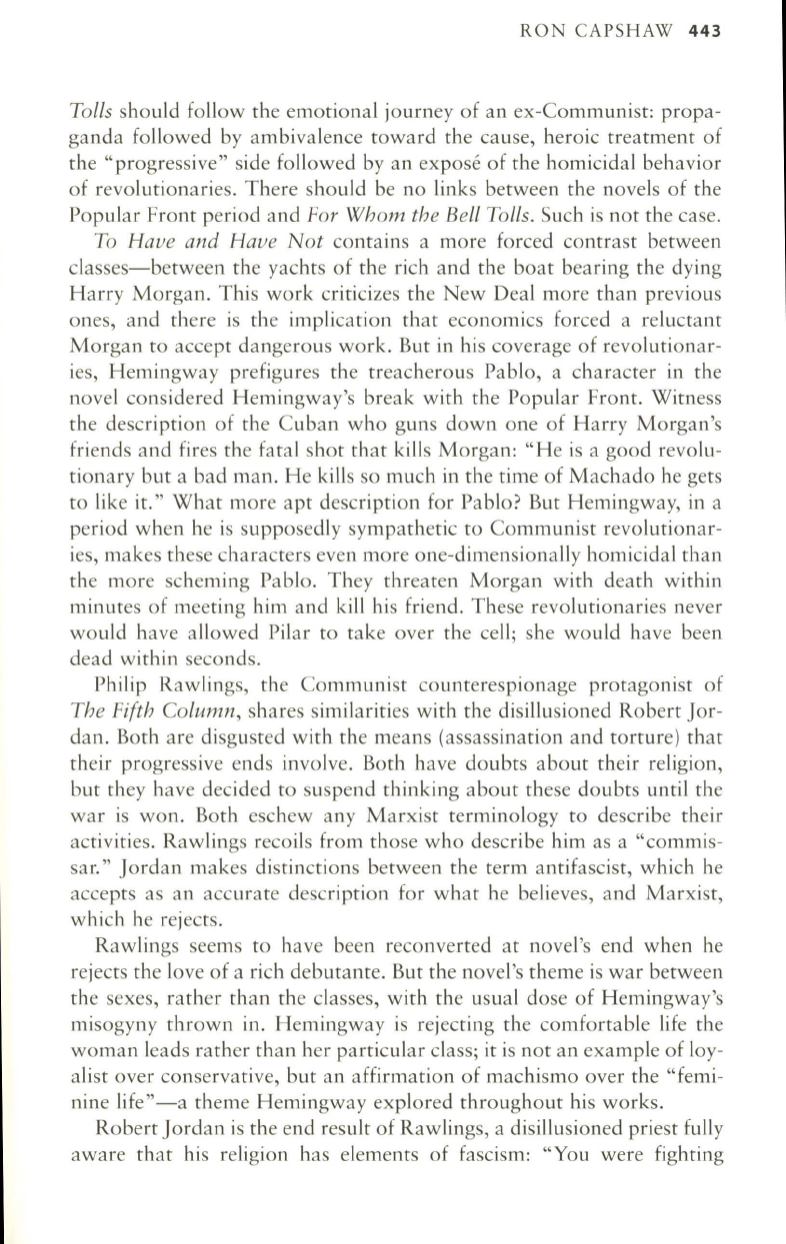
RON CAPSHAW
443
Tolls
should follow the emotional journey of an ex-Communist: propa–
ganda followed by ambivalence toward the cause, heroic treatment of
the "progressive" side followed by an expose of the homicidal behavior
of revolutionaries. There should be no links between the novels of the
Popular Front period and
For Whom the Bell Tolls.
Such is not the case.
To
Have and Have Not
contains a more forced contrast between
classes-between the yachts of the rich and the boat bearing the dying
Harry Morgan. This work criticizes the New Deal more than previous
ones, and there is the implication that economics forced a reluctant
Morgan to accept dangerous work. But in his coverage of revolutionar–
ies, Hemingway prefigures the treacherous Pablo, a character in the
novel considered Hemingway's break with the Popular Front. Witness
the description of the Cuban who guns down one of Harry Morgan's
friends and fires the fatal shot that kills Morgan: "He is a good revolu–
tionary but a bad man. He kills so much in the time of Machado he gets
to like it." What more apt description for Pablo? But Hemingway, in a
period when he is supposedly sympathetic to Communist revolutionar–
ies, makes these characters even more one-dimensionally homicidal than
the more scheming Pablo. They threaten Morgan with death within
minutes of meeting him and kill his friend. These revolutionaries never
would have allowed Pilar to take over the cell; she would have been
dead within seconds.
Philip Rawlings, the Communist counterespionage protagonist of
The Fifth Column,
shares similarities with the disillusioned Robert Jor–
dan. Both are disgusted with the means (assassination and torture) that
their progressive ends involve. Both have doubts about their religion,
but they have decided to suspend thinking about these doubts until the
war is won. Both eschew any Marxist terminology to describe their
activities. Rawlings recoils from those who describe him as a "commis–
sar." Jordan makes distinctions between the term antifascist, which he
accepts as an accurate description for what he believes, and Marxist,
which he rejects.
Rawlings seems to have been reconverted at novel's end when he
rejects the love of a rich debutante. But the novel's theme is war between
the sexes, rather than the classes, with the usual dose of Hemingway's
misogyny thrown in. Hemingway is rejecting the comfortable life the
woman leads rather than her particular class; it is not an example of loy–
alist over conservative, but an affirmation of machismo over the "femi–
nine life"-a theme Hemingway explored throughout his works.
Robert Jordan is the end result of Rawlings, a disillusioned priest fully
aware that his religion has elements of fascism: "You were fighting


